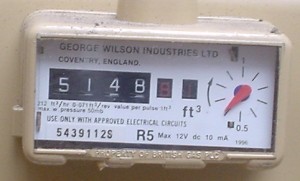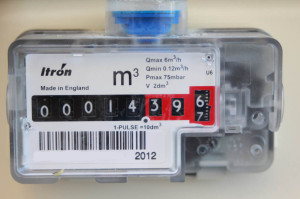We’d like to remind Forumites to please avoid political debate on the Forum.
This is to keep it a safe and useful space for MoneySaving discussions. Threads that are – or become – political in nature may be removed in line with the Forum’s rules. Thank you for your understanding.
📨 Have you signed up to the Forum's new Email Digest yet? Get a selection of trending threads sent straight to your inbox daily, weekly or monthly!
A little mental puzzle when reading an electricity meter
Comments
-
As others have said, for billing purposes, it doesn't matter. However, if it's to allow you to calculate your usage more accurately over a short time period, could you not read the numbers after the decimal place so that the reading is more precise? Are there any types of meter that only show an integer number of kWh? I thought digital meters have a decimal point and then more digits, and old-fashioned meters have the red numbers.JohnB47 said:
Thank you. Of course you are correct but I wasn't remotely thinking of wriggling out of anything or not paying a bill. How did you get that idea?MalMonroe said:Hi,
I am no mathematician but I would think that in the end, it doesn't really matter because everything gets evened out in the end and the energy company will send you a bill and you have to pay it and there's no way to wriggle out of it. Just my own experience.
If you don't pay your bill then nasty things could happen. Or so I've heard!
It was purely a question about actual energy usage when you have an electricity meter that shows whole Kwh. Just a little mental arithmetic puzzle.
0 -
In the OP it was specified the meter "provides readings in whole Kwh".jrawle said:
As others have said, for billing purposes, it doesn't matter. However, if it's to allow you to calculate your usage more accurately over a short time period, could you not read the numbers after the decimal place so that the reading is more precise? Are there any types of meter that only show an integer number of kWh? I thought digital meters have a decimal point and then more digits, and old-fashioned meters have the red numbers.JohnB47 said:
Thank you. Of course you are correct but I wasn't remotely thinking of wriggling out of anything or not paying a bill. How did you get that idea?MalMonroe said:Hi,
I am no mathematician but I would think that in the end, it doesn't really matter because everything gets evened out in the end and the energy company will send you a bill and you have to pay it and there's no way to wriggle out of it. Just my own experience.
If you don't pay your bill then nasty things could happen. Or so I've heard!
It was purely a question about actual energy usage when you have an electricity meter that shows whole Kwh. Just a little mental arithmetic puzzle.
Ours does too, it's literally just a digital display of a whole number, no decimal point.
1 -
Yes, exactly this.Spoonie_Turtle said:
In the OP it was specified the meter "provides readings in whole Kwh".jrawle said:
As others have said, for billing purposes, it doesn't matter. However, if it's to allow you to calculate your usage more accurately over a short time period, could you not read the numbers after the decimal place so that the reading is more precise? Are there any types of meter that only show an integer number of kWh? I thought digital meters have a decimal point and then more digits, and old-fashioned meters have the red numbers.JohnB47 said:
Thank you. Of course you are correct but I wasn't remotely thinking of wriggling out of anything or not paying a bill. How did you get that idea?MalMonroe said:Hi,
I am no mathematician but I would think that in the end, it doesn't really matter because everything gets evened out in the end and the energy company will send you a bill and you have to pay it and there's no way to wriggle out of it. Just my own experience.
If you don't pay your bill then nasty things could happen. Or so I've heard!
It was purely a question about actual energy usage when you have an electricity meter that shows whole Kwh. Just a little mental arithmetic puzzle.
Ours does too, it's literally just a digital display of a whole number, no decimal point.0 -
Thanks. I haven't got one if those monitors. I'm surprised that they don't all measure in a more detailed way.BooJewels said:I've been following a similar thought myself @JohnB47. I have just got a couple of the Tapo P110 energy monitors and have one on my freezer and one on the washing machine.
Disappointingly they only record consumption in 100Wh increments - which means the data is less useful over smaller loads and shorter time periods. 0.1kWh could be 100Wh or 199Wh. So I've decided - for my purposes - to assume it's half way between the reading and the next increment and count it as 150Wh etc. hoping it will balance out Although I did just look at the freezer one, before I put some of my food delivery away and between screen views it did flip over from 0.9kWh to 1kWh - so the time of that is a useful data point - but that was pure chance.
You'd think, if they can display power draw to a tenth of a watt, they could record consumption to a watt hour, or even 10.0 -
its even worse with gas meters. one unit for us is 32kwAlmost everything will work again if you unplug it for a few minutes, including you. Anne Lamott
It's amazing how those with a can-do attitude and willingness to 'pitch in and work' get all the luck, isn't it?
Please consider buying some pet food and giving it to your local food bank collection or animal charity. Animals aren't to blame for the cost of living crisis.0 -
ariarnia said:its even worse with gas meters. one unit for us is 32kwIf a full unit is 32kWh, you've got an imperial meter measuring in hundreds of cubic feet. There will usually be red dials that you don't report to your supplier that show single cubic feet, plus something like the spinning pointer in the photo that shows fractions of cubic feet.
 The smallest increment on that meter is 1/10th of a cubic foot, 0.032kWh.With a metric gas meter, a full unit is 11kWh but you will normally have three decimal places that you don't read. These measure down to indivivual litres of gas, 0.011kWh.
The smallest increment on that meter is 1/10th of a cubic foot, 0.032kWh.With a metric gas meter, a full unit is 11kWh but you will normally have three decimal places that you don't read. These measure down to indivivual litres of gas, 0.011kWh. N. Hampshire, he/him. Octopus Intelligent Go elec & Tracker gas / Vodafone BB / iD mobile. Ripple Kirk Hill Coop member.Ofgem cap table, Ofgem cap explainer. Economy 7 cap explainer. Gas vs E7 vs peak elec heating costs, Best kettle!
N. Hampshire, he/him. Octopus Intelligent Go elec & Tracker gas / Vodafone BB / iD mobile. Ripple Kirk Hill Coop member.Ofgem cap table, Ofgem cap explainer. Economy 7 cap explainer. Gas vs E7 vs peak elec heating costs, Best kettle!
2.72kWp PV facing SSW installed Jan 2012. 11 x 247w panels, 3.6kw inverter. 34 MWh generated, long-term average 2.6 Os.0 -
Bear in mind that the Hundreds of Cubic foot to kWh calculation contains a variable, month to month, which is the calorific value of the gas.
For this type of gas meter (same as mine), the formula to convert each whole gas metered unit (100CuFt) to kWh is:
100CuFt × 2.83 × 1.02264 × Val ÷ 3.6 = kWh
Where Val is the variable calorific value. Mine was 38.0 (rounded up) on my last Octopus bill.
So my September gas consumption of 4 metered units produced:
4.0 × 2.83 × 1.02264 × 38.0 ÷ 3.6 = 122.2 kWh
Which is 30.55 kWh per metered unit, for that period.
0
Confirm your email address to Create Threads and Reply

Categories
- All Categories
- 352.2K Banking & Borrowing
- 253.6K Reduce Debt & Boost Income
- 454.3K Spending & Discounts
- 245.2K Work, Benefits & Business
- 600.9K Mortgages, Homes & Bills
- 177.5K Life & Family
- 259K Travel & Transport
- 1.5M Hobbies & Leisure
- 16K Discuss & Feedback
- 37.7K Read-Only Boards




